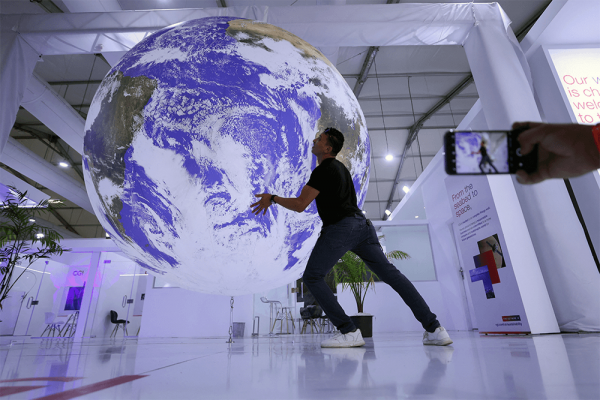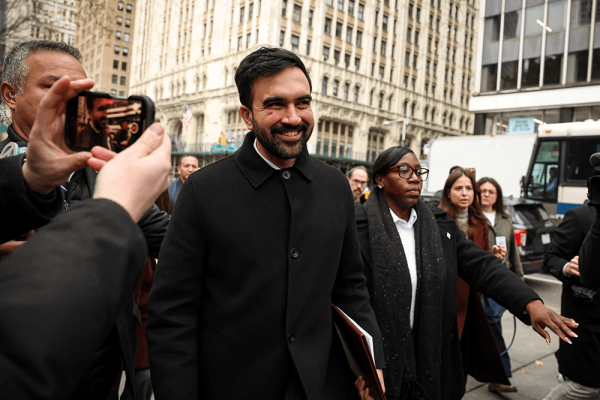A couple of weeks ago, the U.N. climate summit in Egypt, COP27, ended with a breakthrough deal to create a “loss and damage” fund that would help developing nations recover from climate disasters — financed by wealthier nations responsible for most of the emissions that are driving climate change.
Though most wealthy nations have not yet offered cash pledges to the fund, it’s a significant step forward. Yet if we’re serious about addressing the dire effects of climate change, we need to tackle another problem: a worsening debt crisis that has left many nations needing exponentially more resources to recover from climate disasters and invest in sustainable development. This will require transforming how large entities like the World Bank and the International Monetary Fund loan money to low- and middle-income nations.
I know talking about international lending policies makes most people want to yawn, but the Bible takes debt — and the people who profit from it — seriously. In his opening Nazareth sermon (Luke 4), Jesus cites the prophet Isaiah to proclaim “the year of the Lord’s favor,” a passage that evokes the ancient instructions for debt forgiveness, such as those found in Deuteronomy 15 (“Every seventh year you shall grant a remission of debts”). While biblical scholars can’t confirm that these Jubilee injunctions were fully lived out, these instructions were understood to be a regular course corrective to extreme inequality and injustice. Other parts of the Bible flat-out forbid charging interest when the person seeking the loan is poor (Exodus 22:25, Leviticus 25:37).
So, if you care about truly addressing the dual crises of extreme poverty and climate change, stay with me. First, let’s consider why low- and middle-income nations have so much debt in the first place. The answer? Low- and middle-income nations face a complex (and expensive) nest of overlapping and mutually exacerbating crises. They face increased energy prices, rising interest rates, the global food crisis, not to mention navigating a pandemic with dramatically less access to vaccines, and nowhere near the $11 trillion economic stimulus that the U.S. and Europe marshaled to get their populations through the worst of the pandemic. As a result, 60 percent of low-income countries are already in or at high risk of a debt crisis — an echo of the crushing debt so many nations faced in the 1990s until the Jubilee debt cancellation movement helped secure substantial relief.
Then comes a hurricane. Or an earthquake. Or historic flooding. Or fires, or droughts, or any other disaster that is becoming more frequent due to climate change. When one of these natural disasters devastates a small, low- or middle-income country, that country generally needs to take out a loan to repair the damage and help their population recover. Because private lending institutions generally view these loans as risky investments, they offer exceptionally high interest rates that make such loans non-starters for these countries. Instead, nations needing a loan for disaster relief often turn to one of the multilateral development banks (MDBs) like the World Bank or the Inter-American Development Bank.
The World Bank was originally created to help rebuild Europe after WWII and subsequently focused on helping countries transition out of poverty by investing in development. I used to work at the World Bank, where I led efforts to build stronger partnerships with faith-based organizations to help achieve the bank’s goals of ending extreme poverty and promoting shared prosperity. Through this work, I saw how the World Bank could make a major difference to mobilize the knowledge and financing needed to achieve these goals; I also saw that MDBs needed further innovation and bolder reforms to help countries meet the climate and development crises they currently face.
Unfortunately, borrowing from MDBs often comes with challenging interest rates and stipulations that the recipient nation must tighten its spending to ensure the loan can eventually be repaid. For many nations this means they must prioritize repaying their debts instead of making critical investments in their nation’s sustainable development. So, when the next hurricane, or earthquake, or flood strikes, they’re once again not prepared. It’s become a devastating cycle of debt and disaster.
The bad news is that institutions like the World Bank aren’t well equipped to deal with the scale and scope of challenges of facing low- and middle-income countries today, especially those related to climate change. The good news is that momentum for bolder reforms of the MDBs is taking shape and building momentum. Which brings me back to COP27.
During the global conference last month, Barbados’ prime minister, Mia Mottley, championed reforms to the World Bank and International Monetary Fund in the Bridgetown Initiative, named for her nation’s capital. Through Mottley’s advocacy, the initiative gained the attention of several influential leaders. The initiative would expand low-interest lending from the IMF and ensure countries hit by natural disasters aren’t expected to keep repaying the loans as they recover. The initiative would also draw on reserve funds from the IMF that can be used in times of crisis (as it did in 2021 to aid in global economic recovery due to the pandemic) to help finance climate mitigation projects in developing countries.
The result? Huge amounts of money could become available to low- and middle-income countries — money that would not only help them recover from the effects of climate change they’re currently facing, but also prepare for future disasters and invest in sustainable development more broadly. These proposals echo reforms to international financial institutions promoted by the ONE campaign as well as the Jubilee USA Network.
In many ways, this moment reminds me of the choice the world faced in the lead up to the new millennium when so many low- and middle-income countries faced both enormous debt and a devastating HIV/AIDS pandemic. In that moment, the HIV/AIDS movement recognized the need to galvanize a paradigm shift and moved wealthy nations from investing paltry millions of dollars for prevention and treatment programs to the billions that were urgently needed. In the face of growing climate disaster, we desperately need a similar paradigm shift that demands bold and transformational proposals along these lines. All this is frankly in the self-interest of the U.S. and other wealthy nations: Breaking the debt and disaster cycle would mean building a more stable and prosperous world in which we collectively avert the direst consequences of climate change and enable all nations and people to thrive.
And for those of us who are people of faith, it’s also clearly the right thing to do — a powerful expression of the Jubilee vision of restoring right relationship.
Got something to say about what you're reading? We value your feedback!







